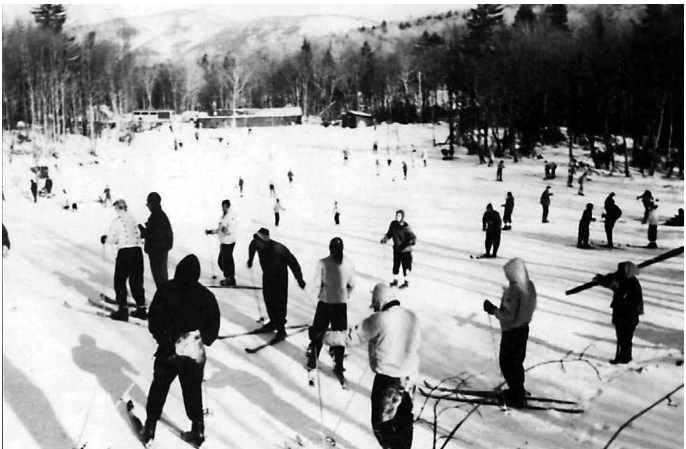By Karen D. Lorentz
Editors’ Note: This is part of a series on the factors that enabled Killington to become the Beast of the East. Quotations are from author interviews conducted in the 1980s for the book Killington, A Story of Mountains and Men.
Recapping this series, we have seen how Pres Smith, inspired by the mountain’s potential and believing in the intrinsic value of skiing, set out to create a better ski experience.
He combined his own passion for the sport with a business opportunity, and thanks to the support of Sue Smith, Joe Sargent, and Wally Morrison, was able to attract a supportive group of investors and a board of directors who, inspired by his vision and motivated by his work ethic, joined him in forming the Sherburne Corporation and building what would become the East’s most successful ski resort.
An unusual stock story
Readers may recall that the Sherburne Corporation had placed would-be investor funds in escrow accounts in 1956 because it didn’t have a lease to the mountain or an access road.
However, with so much accomplished on the mountain and the access road survey and preliminary engineering work done by the state, it was decided that the terms of the escrow agreement had been substantially met, and the directors advised the escrow agent to release the funds in September 1957. A letter was sent to all stock subscribers informing them of the dissolution of the Escrow Account and advising them regarding their Sherburne Corporation stock certificates.
The first “actual” stock issue had a seven-page offering circular dated September 25, 1957. It described the project, its financial status, and plans and listed the 49 outstanding shares of stock then owned by the officers and directors. (Joe Sargent had upped his investment to 39 shares, Mary Sargent held 1 share, Pres Smith 3, Sue Smith 1, Joe Van Vleck 3, and Walter Morrison 2.) All had paid $250 per share, thus making possible the purchase of the farmhouse, down payments on the equipment used to build the work road, the start of construction at the mountain, and the purchase of two lifts.
Joe Sargent explained that it was an unusual way for a company to begin a business. “Normally, the founders would give themselves so many shares of stock and then go out and sell stock and let the shareholders assume the risk should the project fail to get off the ground. But we paid upfront so that we took all the risk, and the shareholders had none until the project was well underway,” he noted.
Their willingness to assume the risk manifested their belief in and dedication to the project. The early sense of responsibility to shareholders was a significant factor because it became an underpinning to a company philosophy and a key element to understanding the conservative workings of the company and the board’s continued involvement with Killington. Board members took much pride in the company’s accomplishments and the track record that the corporation so carefully maintained.
Through a series of stock splits and corporate restructuring, an original investment of four shares of Sherburne Corporation stock increased to 9,600 shares of S-K-I Ltd. A $1,000 1958 investment was worth over $120,000 in July 1988 and $153,600 in July 1989. With another 5-for-4 split, those 9,600 shares became 12,000 shares that were worth $216,000 on June 28, 1996, when the company was sold.
Shoestring start shows promise
Killington opened with seven trails and two Pomalifts operating on Snowdon, a CCC prefab base lodge (put up by the state, which hadn’t had time to build the base lodge), an eight-holer outhouse nearby, and a converted chicken coop for a ticket booth. By the end of January 1959, the Glades Poma and beginner area “Model C” Poma were operating, although not always smoothly.
There were many kinks to be worked out in lift operations in those days. Smith vividly recalled running up the novice slope by the base lodge, hot dog in one hand, soda in the other, to scamper up a lift tower to unjam a lift hanger. “The hard part was swinging hand-over-hand, monkey-bar style, down fifty feet of cable before climbing up over the bull wheel to get to the hangar,” he recalled of being part gymnast in the early days of ski area operations.
Despite the original “shoestring start,” Killington Basin, as the ski area was originally known, had four lifts operating its first season, a record at that time. Some 8,000 skier visits were recorded during four months of operation, and over 100 stockholders had invested by the end of the ski season. By early 1959, the first stock issue was sold out, and a 100-percent stock dividend (two-for-one split) was declared on February 19.
What would have been a less impressive start in 1956 or 1957 with only two lifts and fewer trails had grown into a promising and larger new ski area. Although lift receipts for December had only reached $1,278.00 and January tallied $2,860.15, February turned the tide with over $10,000 in lift revenues!
Killington lost money that first season — the only year in which the ski area did not make a profit in its history, an enviable and unique record among ski resorts. With gross receipts of $42,847.67, the area lost $21,045.22 for its first fiscal year ended July 31, 1959.
However, the books for February and March alone indicated a profitable operation, which helped secure a Vermont Development Credit Corporation loan for the addition of a chairlift and more trails for the 1959–60 ski season.
A new stock issue of 480 shares commenced on April 3, 1959, to raise $120,000 for the purchase of a chairlift to Killington Peak, the clearing of its liftline, and new trails.
Humble beginnings with soul
While Stratton hired a helicopter to install its first chairlift in 1961 and Sugarbush opened in December 1958 with a three-passenger 9,300-foot-long gondola, Killington workers cobbled together a “gin pole” to install its first Pomalifts and then installed the first chairlift towers in 1959 with the aid of a crane.
However, the chairlift’s late delivery on Thanksgiving Day made the installation particularly challenging, as the ground was already covered with 13 feet of snow!
But even more perplexing for Smith was the discovery that one of the newly bolted-together lattice towers looked different from the rest. Working in the dark, frigid air of a December night under car lights, Joe Sargent had bolted his tower together inside out, and the bolts were frozen solid!
Amateurs? Yes, definitely. But their hearts were in it. And souls. And that was to make all the difference.
The passion for creating a better ski experience was found in those long nights, as well as in the mishaps and best-laid plans that sometimes went astray.
In explaining why they were so involved with the physical construction of the ski area from the beginning, Sargent stressed, “We couldn’t afford to let someone else put the lift up and mess it up because we had no money. There was no one to bail us out if someone else erred. We could simply not afford to take the risk of someone else doing it wrong with what little stockholder capital we had.”
Sargent’s desire for a hands-on, do-it-yourself approach was perfect for the genius lurking inside Pres Smith. For a man with a dream and determination as big as Smith’s, the avenue to accomplishment was simple now. To reach the summit, he had only to follow the step-by-step, methodical procedures that his mind so easily intuited from its vision.
Smith didn’t need millions to develop Killington because he was perfectly capable of succeeding with what he had. And what he had was the right combination: the majestic mountains, capable backers, loyal workers, and his own innate drive and vision. A dedicated, supportive colleague in Sue Smith, an intelligent, creative partner in Joe Sargent, and the analytical expertise provided by Morrison assured success no matter how difficult the struggle.
The conservative business approach to ski area development was in place. Foreshadowed by Sargent’s cautious business ethic — avoid risk with others’ money and be sure to make a slow but steady profit — Smith and the board of directors embraced an attitude of fiscal responsibility. It made the dream possible, and entrepreneur, ski area, and corporation would thrive.
Next week, we’ll visit the perseverance and pioneering progress that set Killington apart and on a path to innovation. Comments and insights are welcome: email [email protected] to share thoughts about skiing in the 1950s.

A converted chicken coop served as the first ticket booth at Killington Basin Ski Area.k




